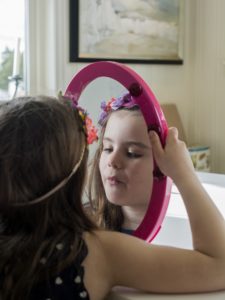- Calls to this hotline are currently being directed to Within Health, Fay or Eating Disorder Solutions
- Representatives are standing by 24/7 to help answer your questions
- All calls are confidential and HIPAA compliant
- There is no obligation or cost to call
- Eating Disorder Hope does not receive any commissions or fees dependent upon which provider you select
- Additional treatment providers are located on our directory or samhsa.gov
Teaching Children to Embrace Their Bodies

When you take the time to examine the reality of body dissatisfaction in our society, it is clearly apparent that this is not just an adult issue.
An increased number of reports are showing children as young as the age of five demonstrating body dissatisfaction, as well as an increased consumption of mainstream media among children putting them at risk of developing unhealthy approaches to their bodies [1].
There are many factors thought to influence how a child feels about themselves and their body, including peers, the media, family, and home environment.
Poor body image can be triggering in a child who may have other risk factors that increase susceptibility to an eating disorder, and promoting positive body image an early age can help a child create a strong appreciation for their bodies. WIth society sending many messages that are counter to body-positivity and acceptance, how can children be taught to embrace their own bodies?
Practicing Body Positivity
Many children will model behaviors of those they are closest to and interact with on a frequent basis. A helpful approach toward teaching children to embrace their bodies is to be a model for this type of behavior. As a parent or guardian of a young child, it is important to reflect on your own self and body.
- Are you verbally negative and critical about your own body?
- Do you find yourself commenting about other’s bodies in a critical manner?
These expressions may become an inner critic for a child who may be vulnerable and sensitive about themselves while still forming their own identity about who they are.
Proactive steps toward body-positivity in the home can start with how bodies are talked about in general. Praising and appreciating what are bodies are capable of doing can help shift the conversation from how we look to how we feel, and this can help bring positive self-awareness and self-esteem into the light for children.
Progress Not Perfection
 Families are under immense pressure for many things, especially when it comes to raising children. Remember that teaching a child positive body image is something that is often modeled, so be sure to keep self-care a priority.
Families are under immense pressure for many things, especially when it comes to raising children. Remember that teaching a child positive body image is something that is often modeled, so be sure to keep self-care a priority.
Parents and loved ones are not to blame for anything, and if you are feeling unsure about how to have a positive effect on your child’s body image, know that you are not alone. Parent support groups offered through the National Eating Disorder Association, as an example, can be a place to find guidance, encouragement, and support, when it comes to guiding a child in a way that supports body-positivity.
 About the Author: Crystal is a Masters-level Registered Dietitian Nutritionist (RDN) with a specialty focus in eating disorders, maternal/child health and wellness, and intuitive eating. Combining clinical experience with a love of social media and writing, Crystal serves as the Director of Content and Social Media for Eating Disorder Hope/Addiction Hope, where her passion to help others find recovery and healing is integrated into each part of her work.
About the Author: Crystal is a Masters-level Registered Dietitian Nutritionist (RDN) with a specialty focus in eating disorders, maternal/child health and wellness, and intuitive eating. Combining clinical experience with a love of social media and writing, Crystal serves as the Director of Content and Social Media for Eating Disorder Hope/Addiction Hope, where her passion to help others find recovery and healing is integrated into each part of her work.
As a Certified Intuitive Eating Counselor, Crystal has dedicated her career to helping others establish a healthy relationship with food and body through her work with EDH/AH and nutrition private practice.
References:
[1]: Common Sense Media, “Children, Teens, Media, and Body Image: A Common Sense Research Brief”, January 21, 2015 https://www.commonsensemedia.org/research/children-teens-media-and-body-imageThe opinions and views of our guest contributors are shared to provide a broad perspective of eating disorders. These are not necessarily the views of Eating Disorder Hope, but an effort to offer discussion of various issues by different concerned individuals.
We at Eating Disorder Hope understand that eating disorders result from a combination of environmental and genetic factors. If you or a loved one are suffering from an eating disorder, please know that there is hope for you, and seek immediate professional help.
Reviewed By: Jacquelyn Ekern, MS, LPC on February 20, 2017
Published on EatingDisorderHope.com

The EatingDisorderHope.com editorial team comprises experienced writers, editors, and medical reviewers specializing in eating disorders, treatment, and mental and behavioral health.

